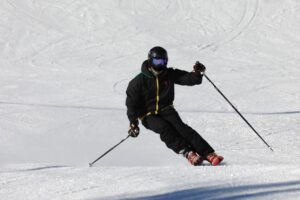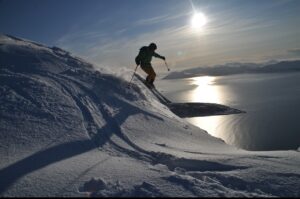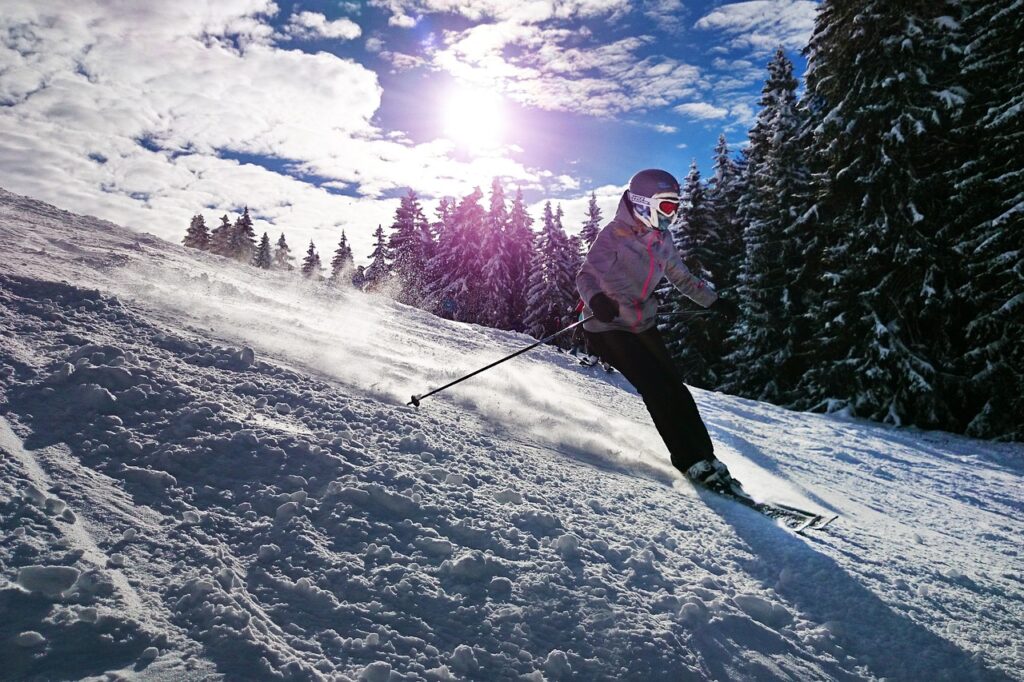SKI FITNESS TRAINING: THE COMPLETE GUIDE WITH KETTLEBELL
Kettlebells for ski fitness?
Downhill skiing involves the whole body and requires good physical condition. The muscles of the legs, arms, back and trunk are all involved in skiing movements. Proper physical preparation can help strengthen these muscles, improve endurance, promote mobility and prevent injury.
Physical preparation is also important for beginner skiers, who need to concentrate on learning ski technique. Indeed, improved physical condition will enable beginners to feel more confident on the slopes and get the most out of their experience.
The aim of this article is to provide practical information onkettlebell training for alpine ski physical preparation. We’ll look at the different physical demands of skiing, the benefits of physical preparation and the different methods of preparation. We’ll also provide tips on how to integrate the kettlebell into your alpine ski training program, so you can improve your fitness and achieve optimum performance on the slopes.
Physical preparation for skiing
The importance of physical preparation in skiing
Alpine skiing is a physically demanding sport. Skiers must be able to withstand rapid changes of direction, abrupt acceleration and deceleration, as well as significant compression and torsional forces on the legs and trunk. Adequate physical condition is therefore essential to be able to ski at your best and prevent injuries.
Physical preparation is essential for skiers of all levels. In addition to developing strength, power, endurance and flexibility, physical preparation can also help prevent injuries. Strong muscles help control the body during descents, reducing the risk of falls and impacts.
In addition, physical preparation can improve skiing technique by helping to maintain good body position and optimal coordination. Better skiing technique can in turn save energy and improve endurance, which can translate into better performance on the slopes.
Physical preparation methods for skiing
There are several methods of physical preparation for downhill skiing. Common methods include strength training, cardio, stretching, proprioception and altitude training.
- Weight training is an effective way of strengthening leg, back and core muscles. Weight-bearing exercises such as squats, lunges and deadlifts can help improve leg strength and power.
- Cardio can help improve endurance and lung capacity. Exercises such as running, cycling, swimming and rowing are all effective in improving overall fitness.
- Stretching is important for improving flexibility and mobility. Stretching can help prevent muscle and joint injuries by improving flexibility.
- Proprioception can help improve balance and coordination. Proprioception exercises often involve working on unstable surfaces or using specific equipment to improve stability and coordination.
- Finally,altitude training can help improve endurance by simulating the high-altitude conditions encountered when skiing in the mountains.

The kettlebell for alpine ski physical preparation
Advantages of the kettlebell for ski fitness training
The kettlebell is a cannonball-shaped body-building tool with a handle. It is used to perform multi-joint and functional muscle-building exercises. The kettlebell allows you to work several muscle groups simultaneously, developing strength, power, endurance and coordination.
The kettlebell is an excellent tool for physical preparation for downhill skiing. In fact, it enables you to work on several physical qualities at the same time, such as strength, power, endurance and coordination. It is particularly useful for strengthening the leg, gluteal, back and abdominal muscles, which are very much in demand when skiing.
The kettlebell also allows you to work your muscles in motion, which is essential for skiing as it requires good coordination and balance. By working with specific exercises, the kettlebell helps prepare skiers to reproduce skiing movements on the slopes.
Specific kettlebell exercises for ski fitness training
There are many specific kettlebell exercises for physical preparation for downhill skiing. Here are a few examples of exercises that can be included in a physical preparation program:
- Kettlebell goblet squat: this exercise strengthens the leg and buttock muscles, which are very much in demand when skiing. It also helps improve coordination and balance.
- Kettlebell deadlift: this exercise strengthens the back and abdominal muscles, which are also very much in demand during downhill skiing. It also helps improve posture and balance.
- Kettlebell swing: this exercise builds power and muscular endurance. It also helps improve coordination and balance.
Mistakes to avoid when using the kettlebell
It’s important not to underestimate the risks involved in using a kettlebell, especially if it’s used incorrectly. Here are some common mistakes to avoid when using the kettlebell for physical preparation for downhill skiing:
- Using a kettlebell that’s too heavy: it’s important to choose a kettlebell that matches your fitness level and abilities. Using a kettlebell that is too heavy can cause injury.
- Using a kettlebell that’s too light : as the aim of physical exercise is to create adaptations, the stimulation must be sufficiently high.
- Not maintaining good posture: it’s important to maintain good posture throughout the exercises to avoid back and joint injuries.
- Not paying attention to technique: it’s important to concentrate on the technique of the movements to avoid injury and maximize the benefits of the exercise.

Alpine skiing kettlebell fitness program
Here’s an example of a kettlebell training program for skiing. The program consists of two standard weeks with two sessions per week. You can repeat the program 3 to 4 times for a total of 6 to 8 weeks of training.
Week 1 – Session 1 :
Dynamic warm-up (5 minutes)
Goblet squat kettlebell: 3 sets of 12 repetitions
Side lunges with kettlebell: 3 sets of 10 repetitions for each leg
Romanian kettlebell deadlift: 3 sets of 10 repetitions
One-handed kettlebell swing: 3 sets of 10 repetitions for each arm
Week 1 – Session 2 :
Dynamic warm-up (5 minutes)
Push-ups with hands on kettlebell: 3 sets of 12 repetitions
Pull: 3 sets of 5 repetitions for each arm
Gainage plank: 3 sets of 30 seconds each
Russian twist with kettlebell: 3 sets of 15 repetitions
Week 2 – Session 1 :
Dynamic warm-up (5 minutes)
Squat jump with kettlebell: 3 sets of 10 repetitions
Forward lunges with kettlebell: 3 sets of 10 repetitions for each leg
Single-leg deadlift with kettlebell: 3 sets of 10 repetitions for each leg
Clean kettlebell: 3 sets of 10 repetitions for each arm
Week 2 – Session 2 :
Dynamic warm-up (5 minutes)
Press with kettlebell: 3 sets of 10 repetitions per arm
Lumberjack pull with kettlebell: 3 sets of 10 repetitions for each arm
Side plank with kettlebell rotation: 3 sets of 30 seconds each side
Russian twist: 3 sets of 15 repetitions
This program is only an example, and should be adapted to suit your fitness level and individual needs. If you’re not sure how to perform the exercises correctly, don’t hesitate to ask for help from a qualified professional to help you avoid injury and achieve your goals.
Other articles that might interest you:
- GPP for running with kettlebell
- MMA physical preparation with kettlebell
- Military training with kettlebell
- Abs exercises with kettlebell
- WOD with kettlebell in CrossFit
- Bodybuilding with kettlebell
- Kettlebell exercises for women
- Kettlebell HIIT
- Kettlebell sport : all you need to know
- Tennis physical preparation with kettlebell
- Handball physical preparation with kettlebell
- Basketball physical preparation with kettlebell
- Rugby physical preparation with kettlebell
- Football physical preparation with kettlebell

